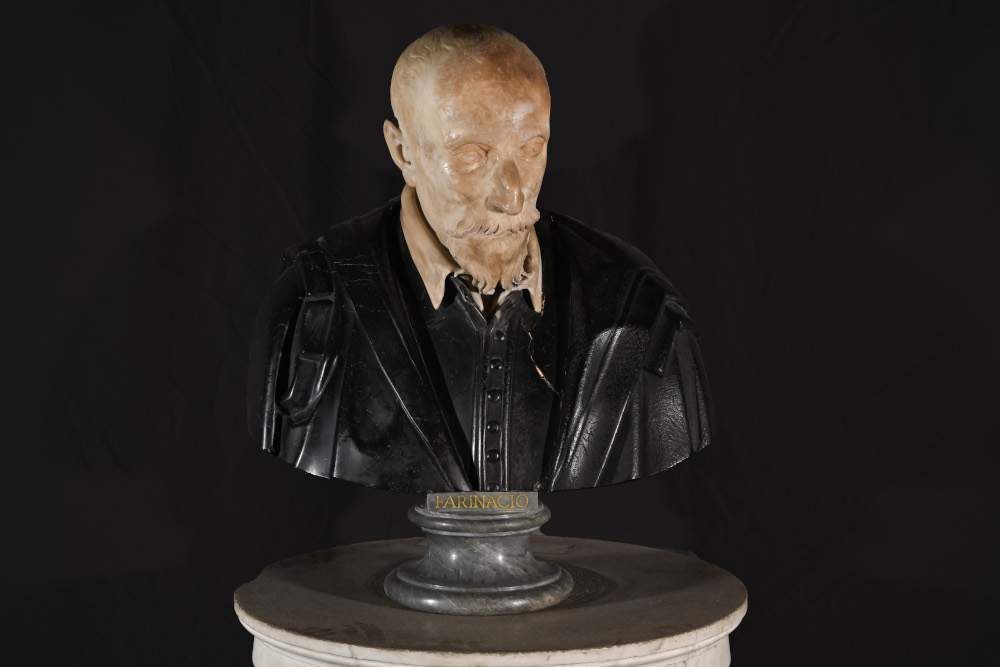A bust-portrait of Prospero Farinacci, a Roman jurist and intellectual who lived between the 16th and 17th centuries, attributed to Gian Lorenzo Bernini, is being donated to the National Museum of Castel Sant’Angelo. The sculpture left the United States to arrive in Italy thanks to the nonprofit organization American Friends of LoveItaly. The work was first donated to AFLI by Marilyn Aronberg Lavin in honor of her husband Irving Lavin, professor emeritus of the Institute for Advanced Study and Grande Ufficiale dell’Ordine al Merito della Repubblica Italiana (2019).
Attributed to Bernini by Professor Lavin himself, the commemorative bust depicts Prospero Farinacci (1544-1618), papal date, auditor general of the Apostolic Chamber and counselor of the Sacra Consulta under Popes Clement VIII and Paul V. An active jurist, his extensive literary records have been cited as an important contribution to the advancement of legal practice. Farinacci is perhaps best known as the defender of the young Roman aristocrat Beatrice Cenci, whose unfortunate affairs were intertwined with the history of Castel Sant’Angelo. Accused of patricide, she was imprisoned and interrogated here, only to be finally executed on September 11, 1599, along with her family members in Piazza di Ponte, in front of the monument. For this reason, the National Museum of Castel Sant’Angelo seemed to be the most appropriate venue to which to assign the sculpture.
The museum already holds a portrait of Prospero Farinacci: a painting by Giuseppe Cesari known as Cavalier D’Arpino, dated 1607 and currently on display in the Dolphin and Salamander Cabinet in the so-called Cagliostra.
The bust in question is a later depiction of the jurist, probably commissioned as a memento to be placed in the Library of San Silvestro al Quirinale, of which Farinacci was a patron. According to the attribution, the bust was made by Gian Lorenzo Bernini in 1619 and consists of different types of marble: the head in Carrara marble, the torso in Belgian marble, and the base in gray marble.
The acquisition of the sculpture by the National Museum of Castel Sant’Angelo represents a further step in telling the public about one of the protagonists of its 16th-century history. The work has been placed in the museum’s Library Room, where it will remain until the end of thedonation process, which will be finalized at the end of three years, according to U.S. legislation. The presentation will take place, in the form of a press conference, on Monday, March 20, at 3 p.m. at the Chapel of the Condemned, which has recently been restored and furnished as a multi-purpose space for events, lectures, video projections and education.
“I am happy that Farinacci’s bust will be displayed in the place where he practiced his profession. It has always been my desire to return a great work of art to Italy in honor of my husband Irving Lavin and the history of art to which he devoted his entire life. I hope that this donation will encourage other collectors, who have like us cherished Italian artistic production, to emulate us,” said bust donor Marilyn Aronberg Lavin.
“This donation is the perfect example of the mission of American Friends of LoveItaly and in particular of LoveItaly’s work in Italy: to encourage people around the world to express their love and appreciation for Italian treasures through patronage,” remarked Richard Hodges, President of American Friends of LoveItaly and LoveItaly. “Professors Lavin’s great generosity is a testament to the fascination with Italy’s artistic and cultural heritage to which they have dedicated their lives, with their vast knowledge of the works. We are honored to be involved in the project, certain that this work will be appreciated by visitors to Castel Sant’Angelo for many decades to come. In conclusion, we are deeply grateful to Dr. Charles Scribner III for making possible, as a sign of deep friendship and professional esteem for Mr. and Mrs. Lavin, the long journey of the work from Princeton, USA, to Rome.”
“The bust of Prospero Farinacci that the American Friends of LoveItaly intends to donate to the National Museum of Castel Sant’Angelo to respect the wishes of its previous owner, Professor Marilyn Lavin, is an event of great cultural caliber for a number of reasons: first and foremost, it has been attributed to the great Gianlorenzo Bernini by Professor Irving Lavin and thus represents the acquisition of an important sculptural work of the Roman Baroque. Second, the valuable work of art returns to Italy after more than a century and a half since it was legally sold on the antiques market to American collectors in the late 1800s. Lastly, Prospero Farinacci’s portrait gives us back an important piece of the long and complex history experienced by Castel Sant’Angelo at the end of the 1500s, which featured a young woman, Beatrice Cenci, who was judged and imprisoned here and whom Prospero Farinacci defended ex officio but failed to save her from being sentenced to death for patricide. Stories that intertwine, then, those of Bernini, Farinacci, Beatrice Cenci, and finally all unravel in the light of a passion, like that of the Lavin couple, and a journey back ’to the origins’ that makes us proud and indebted to the spirit of American patronage. The Direction of the National Museum of Castel Sant’Angelo is deeply grateful to the Director of the Galleria Borghese, Professor Francesca Cappelletti, for the valuable personal contribution she made so that the process of donating the sculpture could begin,” concluded Mariastella Margozzi, Director of the State Museums of the City of Rome.
 |
| Bust-portrait of Prospero Farinacci attributed to Bernini donated to Castel SantAngelo Museum |
Warning: the translation into English of the original Italian article was created using automatic tools. We undertake to review all articles, but we do not guarantee the total absence of inaccuracies in the translation due to the program. You can find the original by clicking on the ITA button. If you find any mistake,please contact us.